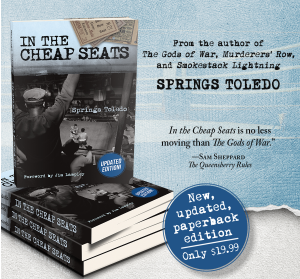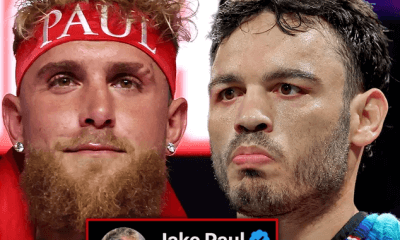Featured Articles
“Jack Demsey’s”…………….A TSS Classic from the pen of Springs Toledo

New York. Late Friday afternoon, I was walking along West 33rd Street thinking about how Bryant Jennings should fight Wlad Klitschko when I did a double-take. One of those dime-a-dozen joints in Midtown Manhattan has a name that still packs the proverbial wallop. The sign said “Jack Demsey’s.”
It takes a blink or two before you realize the “p” is missing.
Jack Dempsey’s Restaurant, the real thing, used to be at 1619 Broadway. For thirty-six years (1938-1974), “The Manassa Mauler” greeted patrons, posed for Polaroids, and startled newcomers with a voice that was nothing like the growl they’d expected. “Hiya pal” he’d chirp, but when his oversized hand clasped yours, you knew. Those oversized hands earned him another moniker in his day—“Jack the Giant Killer.” Despite standing a little over six feet and weighing less than a cruiserweight, it took him not one round to land a punch to the solar plexus that left six feet, four inches of Carl Morris writhing on the canvas. It took not one round before Fred Fulton’s seconds had to drag all six feet six dead-to-the-world inches of him back to the corner. And then came Jess Willard, boxing’s first super-heavyweight champion. Dempsey greeted him with violence so visceral it remains disturbing to watch even today.
Violence saturates New York City’s history like a blood-soaked towel. From the 1960s into the 1990s, when Mayor Rudy Giuliani looked behind crime’s curtain to see all those broken windows that needed repairing, the city was seething and unsafe. In 1969, Dempsey himself was the target of an attempted mugging in Manhattan, but he flattened both of his attackers. He was 74. “I just let ’em lie there and walked away,” he said.
Things have calmed down since, gotten good even, though visitors find out the hard way that the city’s aggression is innate. It’s on the avenues where countless yellow cabs dart like fireflies night and day; in the pitched-forward posture of drivers leaning on horns and glowering through windshields; on the sardine sidewalks where stopping to tie your shoe can earn you a piledriver with no apology. In NYC, everyone is Dempsey.
Early Saturday evening, I was walking along East 33rd Street toward Madison Square Garden and thinking again about how Bryant Jennings should fight Wlad Klitschko when a loud type standing on the corner at Seventh Avenue almost impaled my shoe with a sirloin steak sign he was thumping on the pavement. “Kleetschko! Kleetschko! Kleetschko!” he said as he cut the air with bargain-bin jabs.
He was spreading the news. Klitschko’s defense of his world heavyweight crown that night was billed as “The Champion Re-turns.” That sounded even better after a couple of blinks. See, whenever the Ukrainian giant defends against a Great American Hope, I tend to wonder if Dempsey will show up.
Ukrainians and Ukrainian Americans sure showed up. They filled the Garden’s nosebleed sections and decorated them with a sea of blue and yellow flags. During the preliminaries two zealous fans tried to drape a big one over the partition of the corridor where the fighters walk to the ring. They flung up the far corners of their flag like a couple would a picnic blanket in Central Park, but it floated down over a stern-faced cop whose hands flew up as he spun around. The couple retreated under his New York glower.
Former champions and celebrities promenaded by the cop as the main event got near. Rudy Giuliani showed up too. I turned around and saw Prince Charles Martin, an American heavyweight prospect who broke an Englishman’s nose in a preliminary bout. “How would you fight Klitschko?” I asked him. He thought for a moment and said “I’d box him.” Martin, who throws tricky shots from an upright stance, was shy about details. I suggested he watch the film of Dempsey-Willard and consider it a crash course in giant toppling.
Jennings’s eyes were wide as he made his way to the ring. I didn’t see fear in them so much as confident awareness. He seemed to be in something of a meditative state. Minutes later the champion appeared with his entourage. His face was a mask of tension. Drenched with sweat, jaw clenched, pupils dilated; it was the face of Kiev or Peski between shellings. To his right a blue and yellow swarm rushed forward to let him know they were there. To his left was press row.
Klitschko’s physical dimensions almost match Jess Willard’s. The only notable difference between them is Willard’s wrist, which was two and a half inches bigger than Klitschko’s.
Before the end of the first round I thought Dempsey may have shown up after all. Jennings was showing agility and moving his head. He threw an overhand right from a low crouch, which the grand old champion identified as his favorite stance and one that is, he said, “invaluable in fighting bigger men.” In the second round, Jennings was jabbing to the body and twisting his torso when Klitschko started throwing those telephone poles at him. Jennings responded by going low and springing into punches that sent the giant skittering away. In the fourth, he threw a whistling left hook followed by an overhand right that missed by an inch.
By then, Prince Charles Martin was no longer shy about details. He was hollering Dempsey-like directions behind me: “Make him fight! Step right into his space! Don’t wait for him! Fire that right hand!”
Klitschko paused and took a deep breath in the fifth round. His objective is always the same—it’s the same as Ukraine’s. He seeks to control his territory. He jabs, he holds. He fires left hooks and right hands when it’s safe to do so. Unlike Ukraine, if his opponent fires back, he’ll clinch. And if he can’t clinch, he’ll make a fast exit, stage right, and try to reset the momentum.
“Controlled panic,” Jennings called it.
Jennings understands the problems presented by the giant. He was more effective than anyone expected in blocking, getting under and moving around the jab, and making Klitschko pay for clinches by banging his flanks. However, he wasn’t banging nearly enough to win more than a few rounds, never mind the heavyweight championship of the world. Martin saw it. “Load that hook up!” he said during the ninth round. “Right hand over the top! Over the top!”
But Dempsey wasn’t at the Garden Saturday night. According to CompuBox, Klitschko’s head absorbed only twenty-six total punches over twelve rounds. Willard’s head absorbed thirty-six power punches in the first round.
Bryant Jennings proved aggressive-ready, but not willing enough. His low crouch was a pose—like an old photograph in one of those dime-a-dozen joints around Midtown Manhattan—like Jack Demsey’s.
Springs Toledo’s writing has been featured on NPR’s Here & Now, recognized over 40 times by the Boxing Writers Association of America (BWAA), and honored in The Best American Essays 2019 and 2020. He is a member of Ring 4 Boston, the BWAA, the International Boxing Hall of Fame Committee, and a co-founder/volunteer on the Transnational Boxing Rankings Board. A native of Boston, Massachusetts, Toledo has also authored several books about boxing. www.SpringsToledo.com.
Editor’s Note: This story originally appeared on this site on April 27, 2015. A new, updated paperback version of Toledo’s “In the Cheap Seats” has just been released. It’s available at AMAZON.COM

To comment on this story in the Fight Forum CLICK HERE
-

 Featured Articles4 weeks ago
Featured Articles4 weeks agoAvila Perspective, Chap. 330: Matchroom in New York plus the Latest on Canelo-Crawford
-

 Featured Articles3 weeks ago
Featured Articles3 weeks agoVito Mielnicki Jr Whitewashes Kamil Gardzielik Before the Home Folks in Newark
-

 Featured Articles22 hours ago
Featured Articles22 hours agoResults and Recaps from New York Where Taylor Edged Serrano Once Again
-

 Featured Articles4 weeks ago
Featured Articles4 weeks agoCatching Up with Clay Moyle Who Talks About His Massive Collection of Boxing Books
-

 Featured Articles5 days ago
Featured Articles5 days agoFrom a Sympathetic Figure to a Pariah: The Travails of Julio Cesar Chavez Jr
-

 Featured Articles3 weeks ago
Featured Articles3 weeks agoMore Medals for Hawaii’s Patricio Family at the USA Boxing Summer Festival
-

 Featured Articles1 week ago
Featured Articles1 week agoCatterall vs Eubank Ends Prematurely; Catterall Wins a Technical Decision
-

 Featured Articles4 weeks ago
Featured Articles4 weeks agoRichardson Hitchins Batters and Stops George Kambosos at Madison Square Garden




















